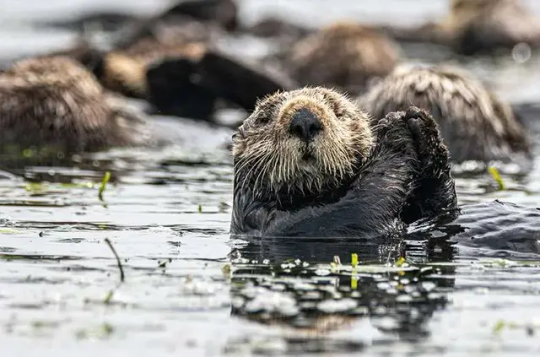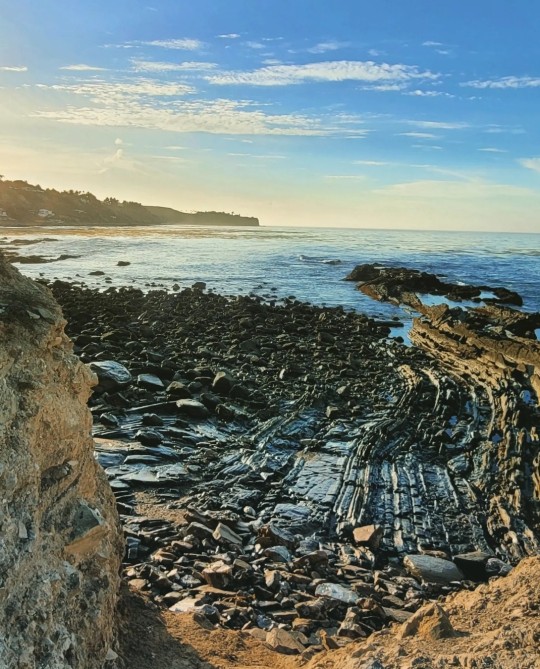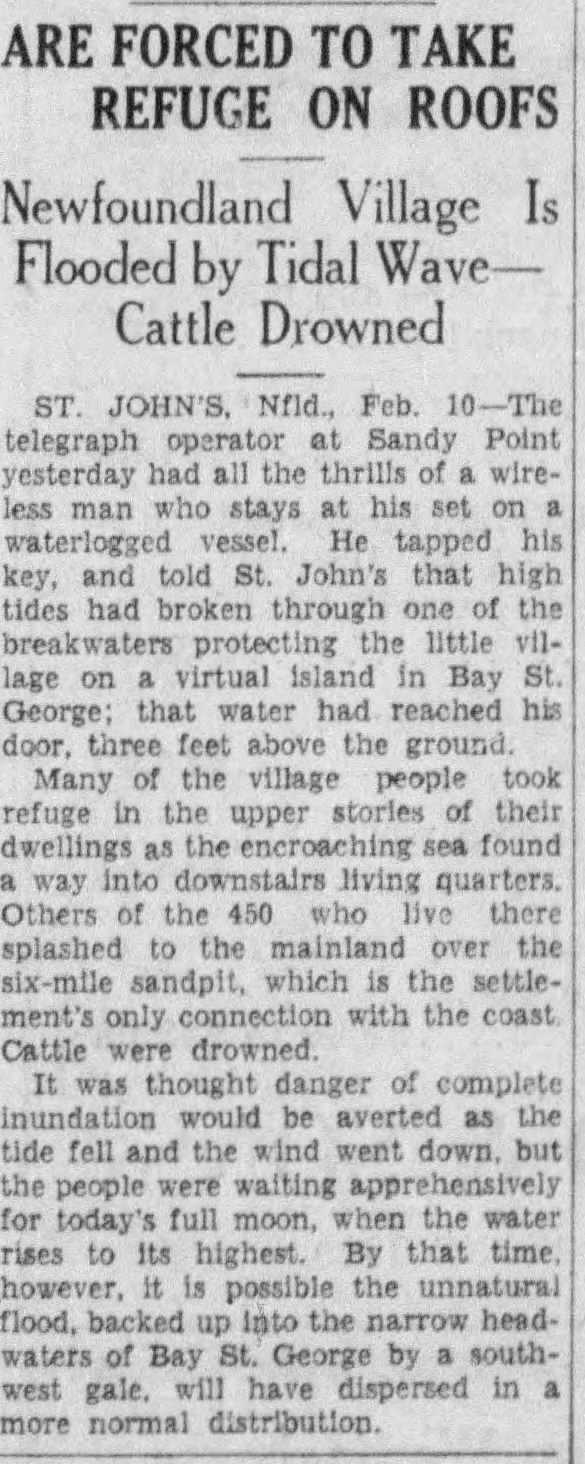#coastal erosion
Text
"Many people know about the Yellowstone wolf miracle. After wolves were reintroduced to the national park in the mid-1990s, streamside bushes that had been grazed to stubble by out-of-control elk populations started bouncing back. Streambank erosion decreased. Creatures such as songbirds that favor greenery along creeks returned. Nearby aspens flourished.
While there is debate about how much of this stemmed from the wolves shrinking the elk population and how much was a subtle shift in elk behavior, the overall change was dramatic. People were captivated by the idea that a single charismatic predator’s return could ripple through an entire ecosystem. The result was trumpeted in publications such as National Geographic.
But have you heard about the sea otters and the salt marshes? Probably not.
It turns out these sleek coastal mammals, hunted nearly to extinction for their plush pelts, can play a wolf-like role in rapidly disappearing salt marshes, according to new research. The findings highlight the transformative power of a top predator, and the potential ecosystem benefits from their return.
“It begs the question: In how many other ecosystems worldwide could the reintroduction of a former top predator yield similar benefits?” said Brian Silliman, a Duke University ecologist involved in the research.
The work focused on Elk Slough, a tidal estuary at the edge of California’s Monterey Bay. The salt marsh lining the slough’s banks has been shrinking for decades. Between 1956 and 2003, the area lost 50% of its salt marshes.
Such tidal marshes are critical to keeping shorelines from eroding into the sea, and they are in decline around the world. The damage is often blamed on a combination of human’s altering coastal water flows, rising seas and nutrient pollution that weakens the roots of marsh plants.
But in Elk Slough, a return of sea otters hinted that their earlier disappearance might have been a factor as well. As many as 300,000 sea otters once swam in the coastal waters of western North America, from Baja California north to the Aleutian Islands. But a fur trade begun by Europeans in the 1700s nearly wiped out the animals, reducing their numbers to just a few thousand by the early 1900s. Southern sea otters, which lived on the California coast, were thought to be extinct until a handful were found in the early 1900s.
In the late 1900s, conservation organizations and government agencies embarked on an effort to revive the southern sea otters, which remain protected under the Endangered Species Act. In Monterey Bay, the Monterey Bay Aquarium selected Elk Slough as a prime place to release orphaned young sea otters taken in by the aquarium.
As the otter numbers grew, the dynamics within the salt marsh changed. Between 2008 and 2018, erosion of tidal creeks in the estuary fell by around 70% as otter numbers recovered from just 11 animals to nearly 120 following a population crash tied to an intense El Niño climate cycle.
While suggestive, those results are hardly bulletproof evidence of a link between otters and erosion. Nor does it explain how that might work.
To get a more detailed picture, the researchers visited 5 small tidal creeks feeding into the main slough. At each one, they enclosed some of the marsh with fencing to keep out otters, while other spots were left open. Over three years, they monitored the diverging fates of the different patches.
The results showed that otter presence made a dramatic difference in the condition of the marsh. They also helped illuminate why this was happening. It comes down to the otters’ appetite for small burrowing crabs that live in the marsh.

Adult otters need to eat around 25% of their body weight every day to endure the cold Pacific Ocean waters, the equivalent of 20 to 25 pounds. And crabs are one of their favorite meals. After three years, crab densities were 68% higher in fenced areas beyond the reach of otters. The number of crab burrows was also higher. At the same time, marsh grasses inside the fences fared worse, with 48% less mass of leaves and stems and 15% less root mass, a critical feature for capturing sediment that could otherwise wash away, the scientists reported in late January in Nature.
The results point to the crabs as a culprit in the decline of the marshes, as they excavate their holes and feed on the plant roots. It also shows the returning otters’ potential as a marsh savior, even in the face of rising sea levels and continued pollution. In tidal creeks with high numbers of otters, creek erosion was just 5 centimeters per year, 69% lower than in creeks with fewer otters and a far cry from earlier erosion of as much as 30 centimeters per year.
“The return of the sea otters didn’t reverse the losses, but it did slow them to a point that these systems could restabilize despite all the other pressures they are subject to,” said Brent Hughes, a biology professor at Sonoma State University and former postdoctoral researcher in Silliman’s Duke lab.
The findings raise the question of whether other coastal ecosystems might benefit from a return of top predators. The scientists note that a number of these places were once filled with such toothy creatures as bears, crocodiles, sharks, wolves, lions and dolphins. Sea otters are still largely absent along much of the West Coast.
As people wrestle to hold back the seas and revive their ailing coasts, a predator revival could offer relatively cheap and effective assistance. “It would cost millions of dollars for humans to rebuild these creek banks and restore these marshes,” Silliman said of Elk Slough. “The sea otters are stabilizing them for free in exchange for an all-you-can-eat crab feast.”"
-via Anthropocene Magazine, February 7, 2024
#otters#sea otters#conservation#erosion#coastal erosion#coastline#marshes#saltwater#marine science#marine biology#marine animals#sea creatures#ocean#sustainability#soil erosion#erosion control#crab#good news#hope
3K notes
·
View notes
Text
Franziska Trautmann is the founder and CEO of Glass Half Full, a recycling company that converts glass into sand for coastal restoration projects and disaster relief. She and her co-founder Max were students at Tulane University when they launched the initiative. Trautmann shares her Brief But Spectacular take on "glassroots" recycling.
530 notes
·
View notes
Text

Acadian Coastal Drive, New Brunswick, Canada (source)
#don’t forget about Canada’s other French-speaking province!#canada#new brunswick#ocean#landscape#cliffs#coastal erosion#coastal landform#geography#geology#geomorphology#beach#lighthouse#atlantic ocean
9 notes
·
View notes
Text

After extremely high tide and strong waves, our beach last night was left even rockier than normal this morning...
© Susan Kramer 2022 All Rights Reserved
#photographers on tumblr#original photographers#landscape#nature#southern california#coastal erosion
130 notes
·
View notes
Text
Billionaire’s Nantucket Beach House Swept Away
#billionaire#nantucket#beach house#swept away#soil erosion#coastal erosion#climate change#global warming#karma#bigot#republican hypocrisy#liberal hypocrisy#hypocrite#gop hypocrisy#jerktrillionaires#jerkbillionaires#jerkmillionaires#earth#econotego#class war#eat the rich#eat the fucking rich#fascist#capitalism#anti capitalist#capitalist hell#capitalist dystopia#capitalist bullshit#ecology#ausgov
2 notes
·
View notes
Text
Ugh. If only archaeology was being done in Libya... It's definitely a place with a huge number of sites, very few of which have been excavated.
11 notes
·
View notes
Text
Watch: Pacifica Coastal Erosion Jan 14 2024
youtube
#it's very expensive to live in Pacifica#king tides#january#2024#coastal erosion#climate change#youtube#drone
2 notes
·
View notes
Link
Excerpt from this story from Vice:
Amtrak has once again suspended train service along the second-busiest rail corridor in the country due to the human impact on coastal erosion. Pacific Surfliner service between San Diego and Los Angeles has been severely impacted, with canceled trains and replacement bus service between Irvine and Oceanside due to coastal erosion in San Clemente where the tracks run right along the coast. The changes were announced Friday, about three weeks before a planned service expansion, and are in effect “until further notice.”
Regional rail operated by MetroLink is also impacted. Its statement cites “continued movement to the right of way in the San Clemente area” that requires the shutdown to “ensure passenger safety.”
The emergency repairs come almost precisely one year after coastal erosion in the same area shut down the important rail line for two weeks. Amtrak did not immediately respond to a Motherboard inquiry as to whether it is the exact same section of track, and if so, what measures are being taken to prevent this from being an annual occurrence. The Los Angeles Times reported heavy rains from Tropical Storm Kay battered the coast with unusually high winds and surf, adding to the erosion.
“Until we have confirmation from the experts the slope movement has stopped, we will not resume Metrolink service,” Metrolink’s statement said.
As Motherboard reported last year, coastal erosion along the Surfliner route is the result of human changes to the natural environment through extensive development and potentially climate change as well. Rivers replenish the coastline with sediment, but many of those rivers have been dammed. Seawalls with rocks and boulders support clifftop houses with ocean views, but rocks are less effective against erosion than sand. Homes along beaches with watered lawns also contribute to erosion through over-watering. And climate change, through higher sea levels, more intense storms, and bigger waves erode the vulnerable beaches and cliffs faster.
21 notes
·
View notes
Link
12 notes
·
View notes
Text
https://hakaimagazine.com/videos-visuals/the-water-is-eating-the-island/
0 notes
Text
Why showcase the benefits of ecosystem restoration?
Through the efforts of over 200 funders and a thousand organisations, more than 1.2 billion euros have been allocated to restoring over 11 million hectares of land and seascape in Europe since 2010. However, there are only a few studies that assess and quantify the benefits of this restoration work. The analysis in today’s report aims to fill this data gap, highlighting how these particular initiatives are enhancing biodiversity and combatting climate change, while also heralding socio-economic benefits. The aim is for these successful projects to inspire more restoration work and demonstrate to communities and local and national decision makers that supporting ecosystems is a win-win for people and nature together.
Five powerful projects in focus

#environment#climate change#initiatives#grassland#invasive species#coastal erosion#biodiversity loss#mountains#trees and forests#degraded forests#reviving degraded forests#safeguard wetlands#wetlands#projects#protected areas#generationrestoration#ecosystem services#soil
0 notes
Link
0 notes
Text
Dr.Tarek Kapiel: The importance of mangrove restoration projects for mitigating climate change
Mangroves are an important part of Egypt’s coastal ecosystems.
A mangrove is a shrub or tree that grows in coastal saline or brackish water. Mangroves are important for biodiversity, carbon storage and coastal protection.
They provide a range of benefits to the environment, economy, and people of Egypt.
They protect the shoreline from erosion and storms; provide habitat for fish and other…

View On WordPress
0 notes
Photo

“ARE FORCED TO TAKE REFUGE 0N ROOFS,” Kingston Whig-Standard. February 10, 1933. Page 1.
----
Newfoundland Village Is Flooded by Tidal Wave — Cattle Drowned
----
ST JOHN'S, Nfld. Feb. 10— The telegraph operator at Sandy Point yesterday had all the thrills of a wireless man who stays at his set on a waterlogged vessel. He tapped his key and told St John's that high tides had broken through one of the breakwaters protecting the little village on a virtual island in Bay St. George, that water had reached his door three feet above the ground.
Many of the village people took refuge in the upper stories of their dwellings as the encroaching sea found a way into downstairs living quarters. Others of the 450 who live there splashed to the mainland over the six-mile sandpit, which is the settlement's only connection with the coast. Cattle were drowned.
It was thought danger of complete inundation would be averted as the tide fell and the wind went down, but the people were waiting apprehensively for today's full moon, when the water rises to the highest. By that time, however, it is possible the unnatural flood, backed up into the narrow head-waters of Bay St. George by a southwest gale will have dispersed In a more normal distribution.
#sandy point#bay st. george#newfoundland history#newfoundland#flooding#st. john's#high tides#dykes#coastal erosion#great depression in canada
0 notes